documenta 14 is not owned by anyone in particular. It is shared among its visitors and artists, readers and writers, as well as all those whose work made it happen.
We write incarcerated by the myth of individual authorship. Whether poetry or prose (or whatever this is) I blow out hard from these puffed-up lungs. And it is all for you, my imagined public. You read entwined and spent, in the stained sheets of a fictional or critical Reception Studies.
O Classics! Is your knowledge worth nothing unless someone just like you knows you know?
It’s not nothing to have a Gods, Monsters, Heroes read by the thousands of Freshmen every semester! You’re just bitter and twisted, turning up your well-picked nose at ivory-tinted infamy. Would anyone not want to earn the public (the public!) and their mush?
We enter an unfinished exhibition. It all started as a split self, The Theater and its Double, ‘Iterability and Otherness’, with Adam Szymczyk and all of those who made documenta 14 happen (circa 2013-2017).

This Tale of Two Cities then somehow spreads elsewhere. To Cleveland, Santa Fe, Sharjah, Berlin, Honolulu, New York Pittsburgh, Chicago, Ottawa, Bergen, Toronto, Sydney, Arnhem on and on (oh my oh my). But when we loop back round to Kassel again (via Jakarta), where will Athens be? In Greece or in Ohio?
Biennial-style exhibitions can be like the Republican party. Relentless in their ambitions, ruthless in their methods, but out of touch with the lives and realities of the majority (especially of the ‘new normal’ under the pandemic), serving a small, privileged section of the population, while touting Art for All like a MAGA hat. This analogy comes to me from the red brick volume 1 of the catalog for An American City – Eleven Exercises (FRONT International: Cleveland Triennial for Contemporary Art 2018).
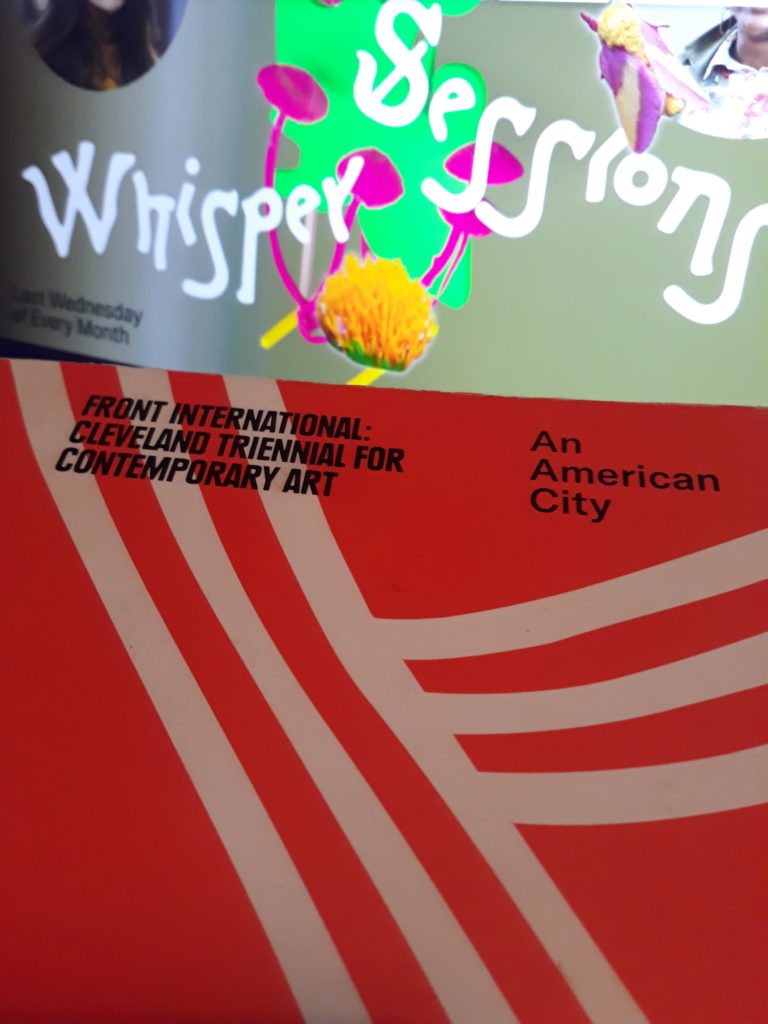
Inside, 220 of its 335 pages were produced by unpaid labor, given/taken for free by/from students. A list of their names as initials (no bios offered/ requested) can be found on a solitary page:
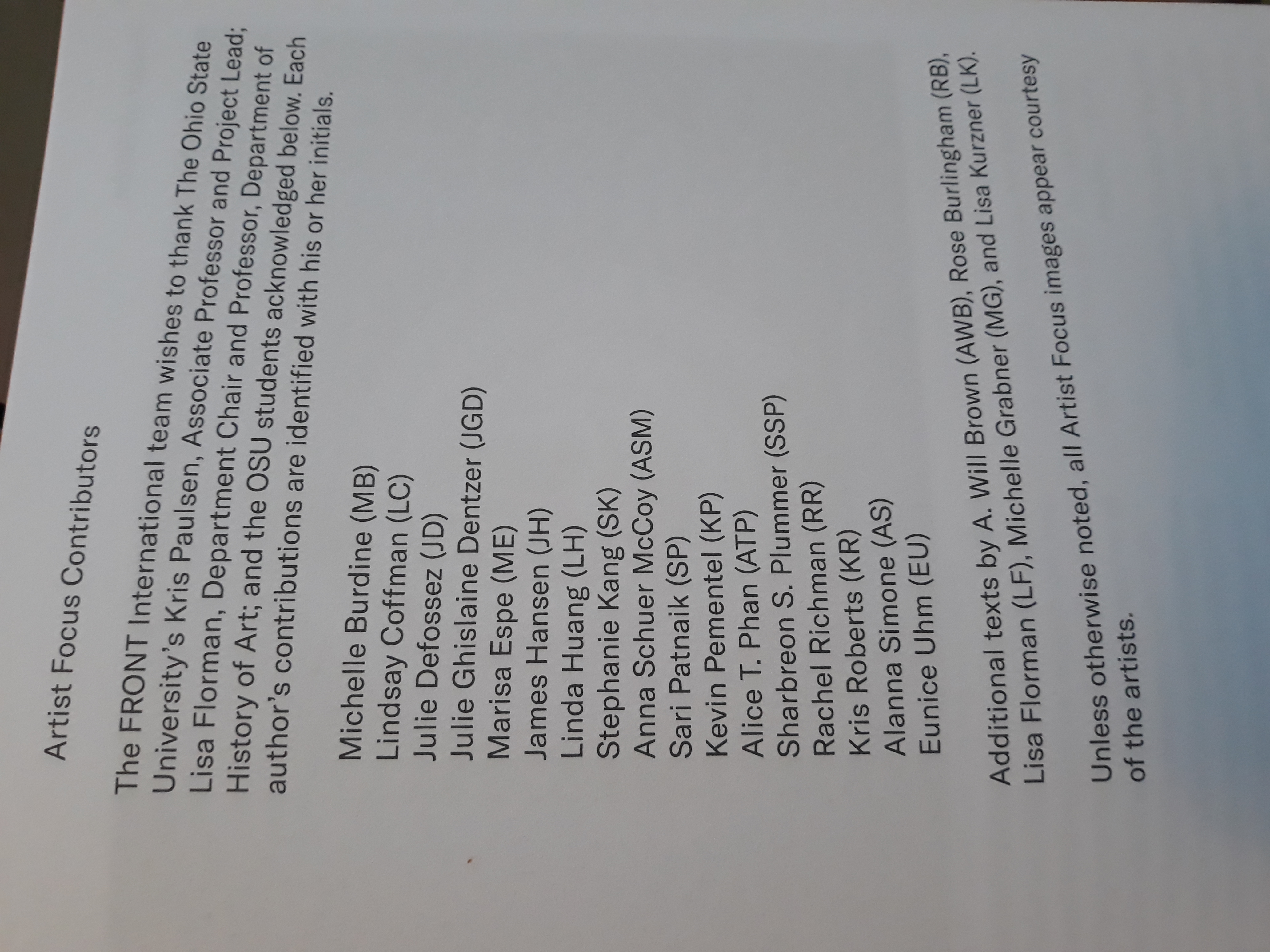
Where are they now? How far has this entry on their CV taken them into the art workforce? Today their names haunt the bold claim on the bottom inner cover and blazoned across the back of the slender, white volume 2, that the next FRONT International will be in July 17-October 2, 2021. (SAVE THE DATE!), since pushed back a year. Today their names haunt this delayed 2nd FRONT (Oh, Gods of Dust and Rainbows!) in other ways too (look for the secret in the Whisper Sessions).
So what do we do with obsolete biennial-style exhibition catalogs? Like the names they contain, they are the portals, the openings, the threads that lead us to an unfinished exhibition. The documenta 14 Daybook takes us to The Empty Daybook; the slim Works section of the purple Whitney Biennial 2019 catalog is overshadowed by the bulky Process section; we turn to Ottawa for the catalog for Àbadakone | Continuous Fire | Feu continuel; meanwhile the blue and red volumes of the tripartite Beyond the Echo Chamber (Sharjah Biennial 14) await their yellow sister; NIRIN NGAAY of the 22nd Sydney Biennale moving between rare art book to open online reader https://nirin-ngaay.net/; while at the back of the Honolulu Biennial 2019, Imaikalani Kalahele addresses us still:
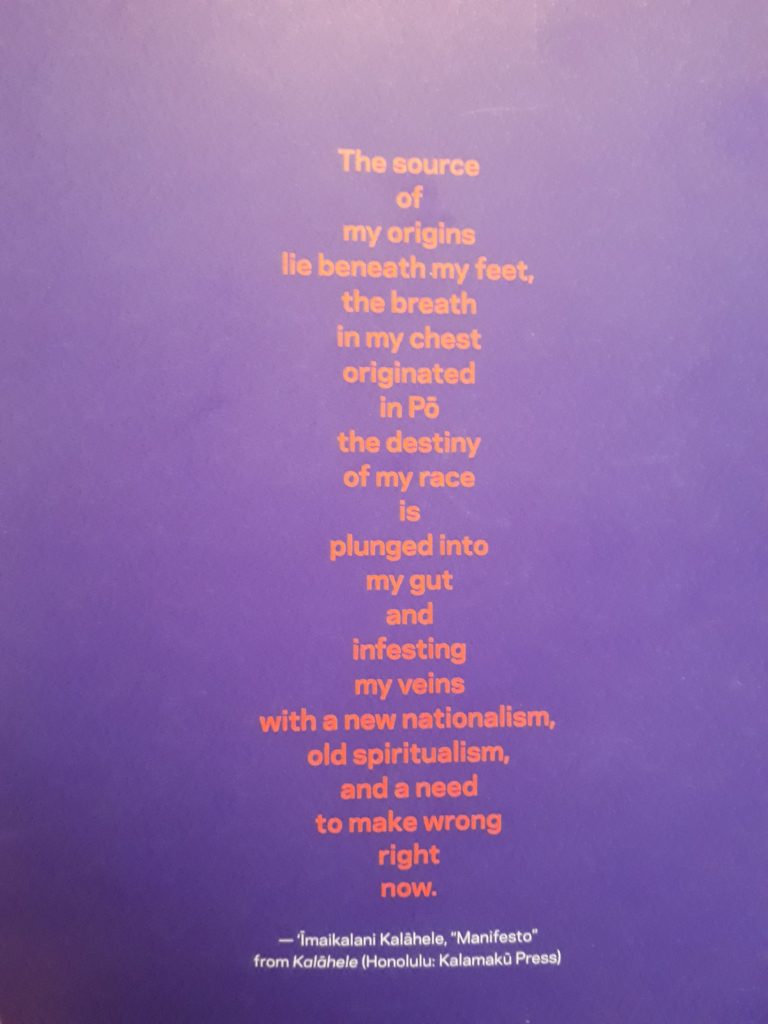
Then there is the network of organizers and curators – all those whose work made it happen. They just don’t stop. For example, in three years, Candice Hopkins went from Learning from Athens (documenta 14 – 2017) to a House Taken Over (Casa Tomada – SITELines Santa Fe 2018) to The Shoreline Dilemma (1st Toronto Biennial – 2019) and on and on. Paul B. Preciado’s The Parliament of Bodies emerged fully-formed at Actually, the Dead Are Not Dead (Bergen Assembly 2019) from its Athens/Kassel decomposition. While the beat of Savvy Contemporary pulsed through everything Bonaventure Soh Bejeng Ndikung has touched, pumping through from Every Time A Ear Di Soun (documenta 14 Public Radio) with Savvy Funk, to perhaps the ultimate proof of an unfinished exhibition mentality in Force Time Distance (Sonsbeek 20-24).
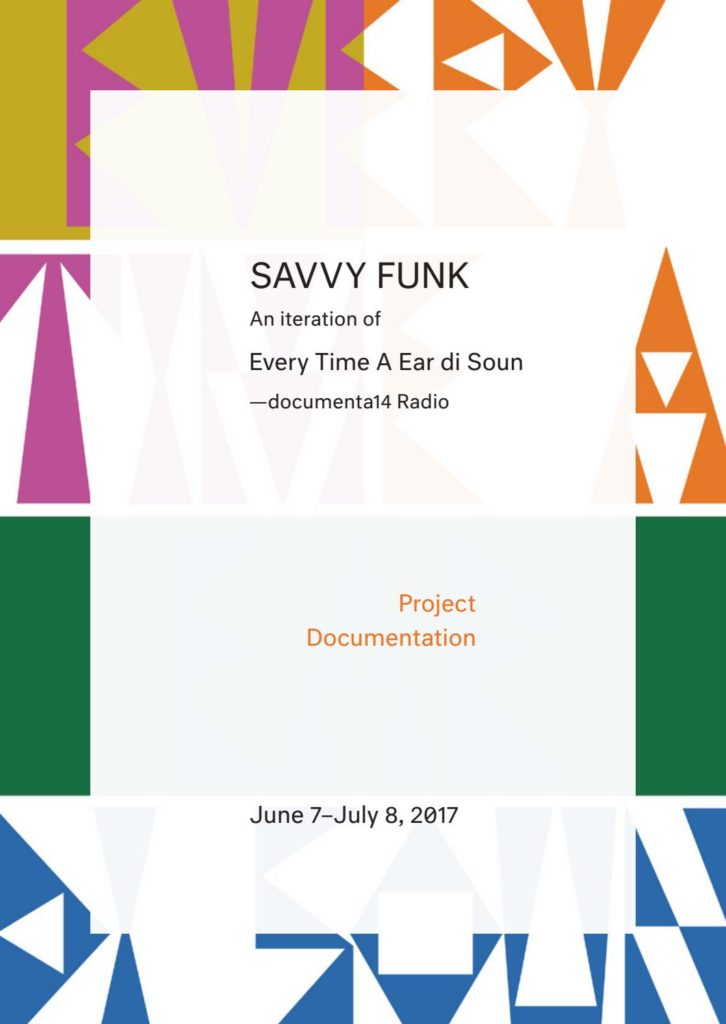
A tale can also be told through two members of the Documenta’s Selection Committees (2013 and 2018) for d14 and D15 to come: Koyo Kouoh and Dig Where You Stand (at the Carnegie International 57th Edition, 2018) and Gabi Ngcobo’s We Don’t Need Another Hero (10th Berlin Biennale 2018).

An unfinished exhibition also emerges from aneducation – documenta 14’s Public Education program, by way of a belated book and its entries’ ongoing resonances (e.g. in classes on decolonial art education here in Columbus, Ohio). From the large-scale expansions of ‘Intimacy’ (Sepake Angiama’s …And Other Such Stories – Chicago Architectural Biennial 2019) and ‘Curriculum’ (Clare Butcher’s TBA (Toronto Biennial of Art) Programs), to a one-night-only session of ‘Gossip’ by Anisa Zeqo at the excruciating clique of the American Academy at Rome called Gossip, Scandal and Good Manners.

I was there and not only did I see Fred Moten in Wu Tsang’s Girltalk for the first time, but I listened to a classicist read from Ovid’s Metamorphoses – the section about the House of Rumor. It goes something like this (in Horace Gregory’s translation):
A mountain-round-house tower is her home.
Innumerable doorways all around it.
A thousand entrances, exits, arcades,
And none with doors. Or night and day
The place keeps open house, and its brass walls
Reflect the lightest word, the lowest whisper;
The place is silent, never noisy,
Yet full of voices, like the sound of waves
Heard from a lighthouse set a mile inshore,
Or like the stilled and trembling trail of sound
Jove’s thunder leaves after black clouds collide.
Through tower halls the Many come to talk,
Lies twisted into truth, truth into lies;
All come and go, and gossip never ends.
Talk, talk, talk, talk fills many hundred ears
That empty as a story’s told, rehashed,
And told to someone else, or fiction grows;
Each time retold adds what is heard
To what’s been said before. And Innocent
Believe-It-All walks there, Deaf-And-Blind Error,
Pushing his way or runs and hides, and dear,
Foolish, Without-A-Leg-To-Stand-On Joy,
Mad Fear, Glib Treason, Confidential Whisper.
Rumor takes in all things at sea, on land,
And, at a distance, in the skies in heaven,
Everything heard or seen throughout the globe.
In the beginning was the Rumor. In Pope.L’s Whispering Campaign – part of three chapters in the book of the same name – on the ground in Athens, Klea Charitou writes:
releasing the first rumor into the unsuspecting world: The sound of skateboard wheels is the hum of bees or the grind of history’s teeth or the whispers of fabulists lost in a forest.
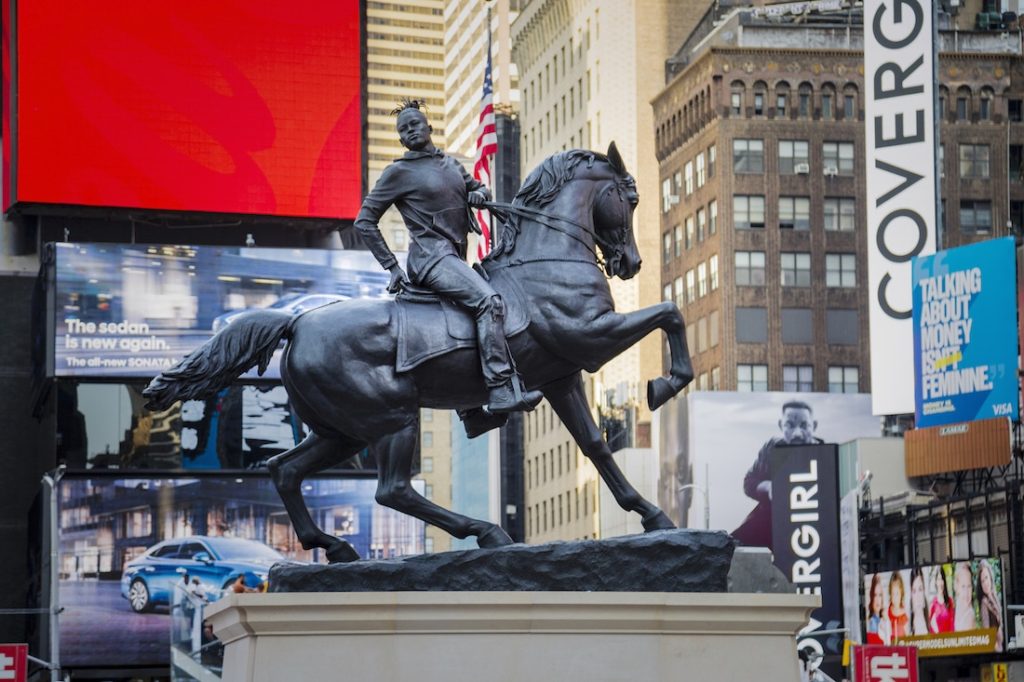
And what of Rumors of War? Beyond Kehinde Wiley’s public sculpture the present moment is one loud of alarm, as the far-right arms for the gerrymandered culture war to come, from the Supreme Court to the afterlife of Trumpism. But as we on the left (center to left) pin our votes and hopes on a Biden/Harris reconciliation, let’s not pretend that it will somehow make us innocent. Colonial aphasia, as Candice Hopkins has taught us, via James Baldwin and Ann Laura Stoler, is ubiquitous now more than ever in these States.
All you need to do is turn to the never-ending Gulf War(s) as an unfinished exhibition. Deep within the pages of the Theater of Operations: The Gulf Wars 1991–2011 catalog, in the essay ‘Embedded Horizons’ by Rijin Sahakian, two black-and-white photographs from Iraqi artist Ali Eyal’s series Behind the Sun (2019) stare back at the US reader.
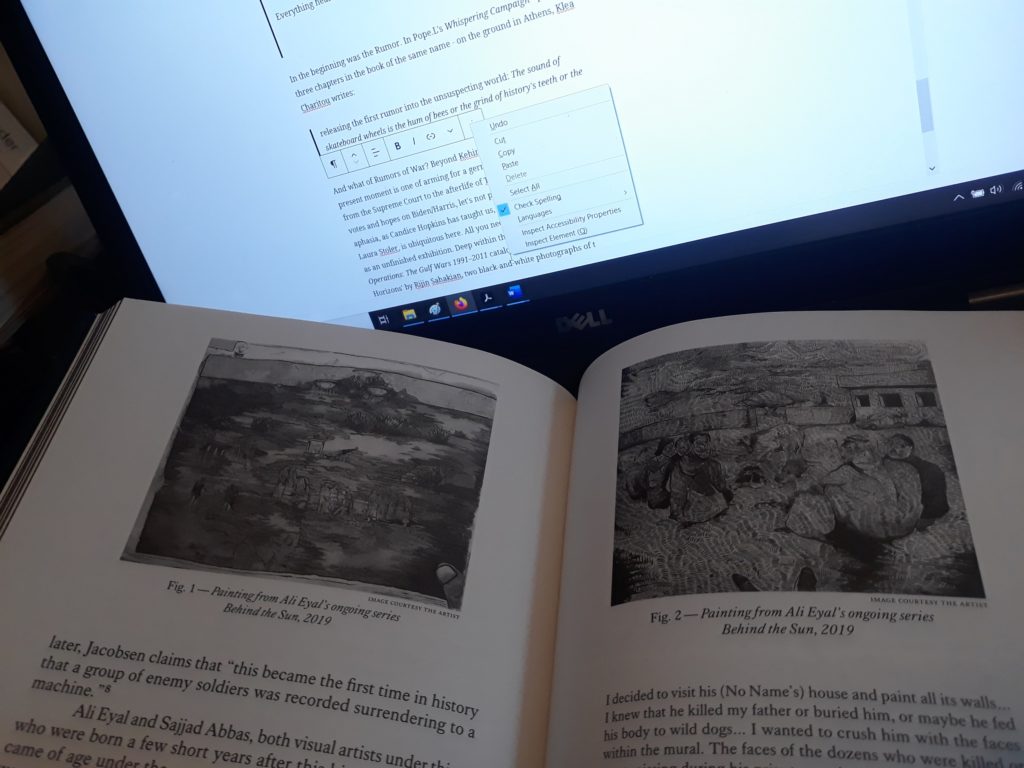
If the secret of an unfinished exhibition is that names continue to haunt, then it is Eyal’s No Name who is the haunted. Here is Eyal’s tale of the Haunting of House No Name in full:
I am the painter in this story, I visit the house of No name, he lives in the end of everything. I decided to visit his house and paint all its walls.

I paint what he is interested in; visual artists, the police, and everyone who knows his fascination with guns. I knew that he killed my father or buried him, or maybe he fed his body to wild dogs.

One of my ideas was to do a giant mural in his living room. I wanted to crush him with the faces within the mural. The faces of the dozens who were killed or went missed during his private parties. I could imagine their eyes following him all around the room.
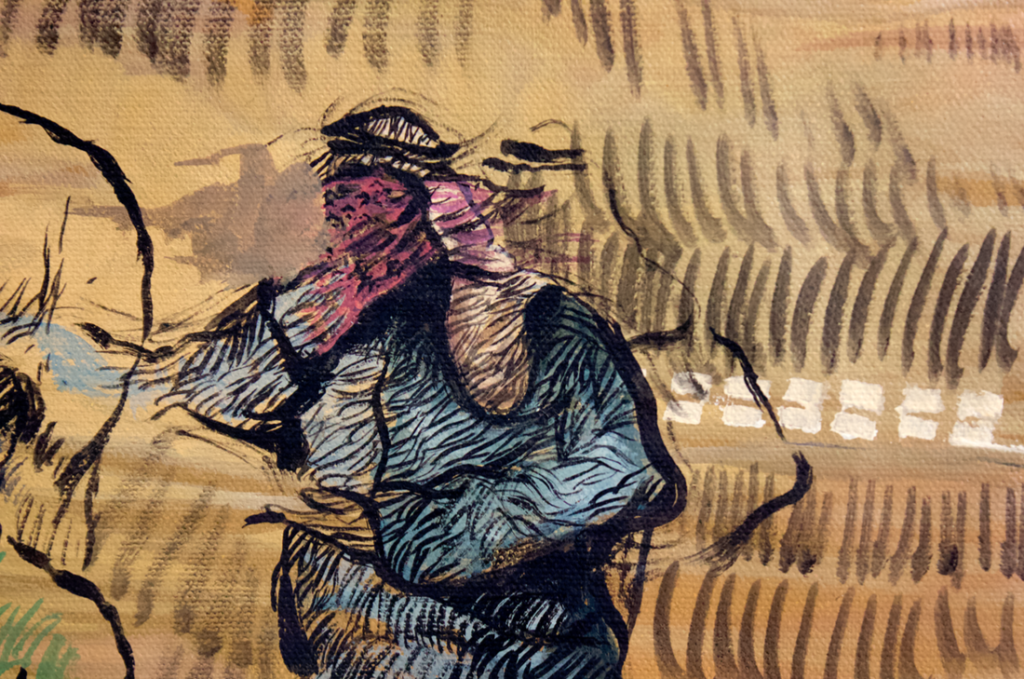
The walls were very old and it was barely possible to paint on them. I finished those paintings knowing that he will soon realize my revenge. One of the paintings showed missing people and victims whose faces I copied from old pictures, collected from multiple families.
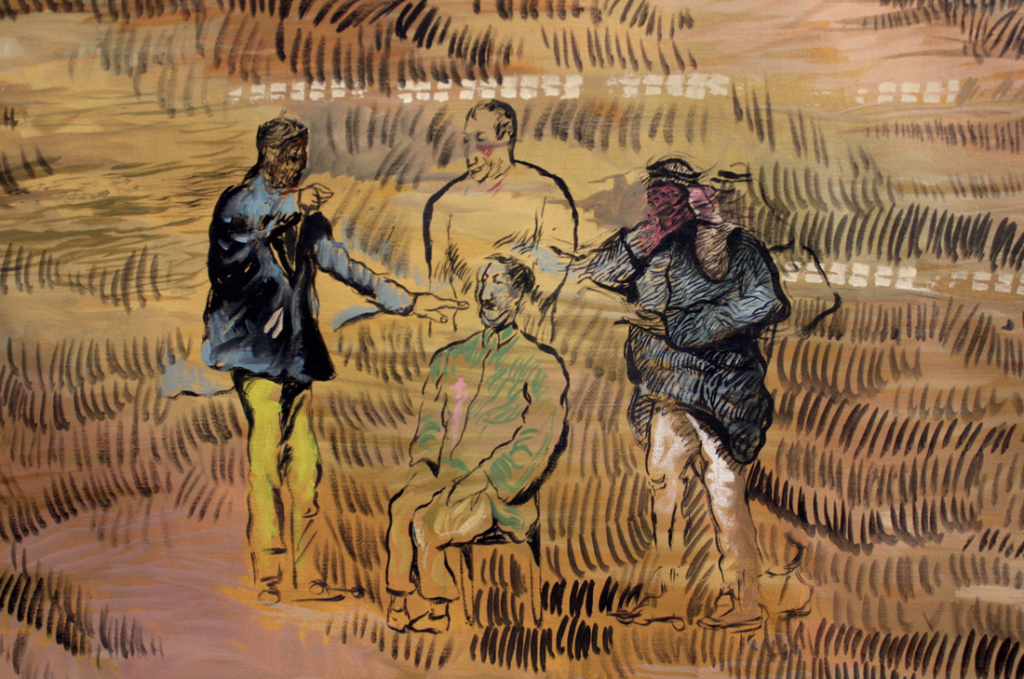
Maybe these configurations will haunt him later. I finished painting and called him to see what I had done. “How marvelous! What an original composition!”, he said. No Name praised me to killers, to everyone. No Name said my work was flawless.
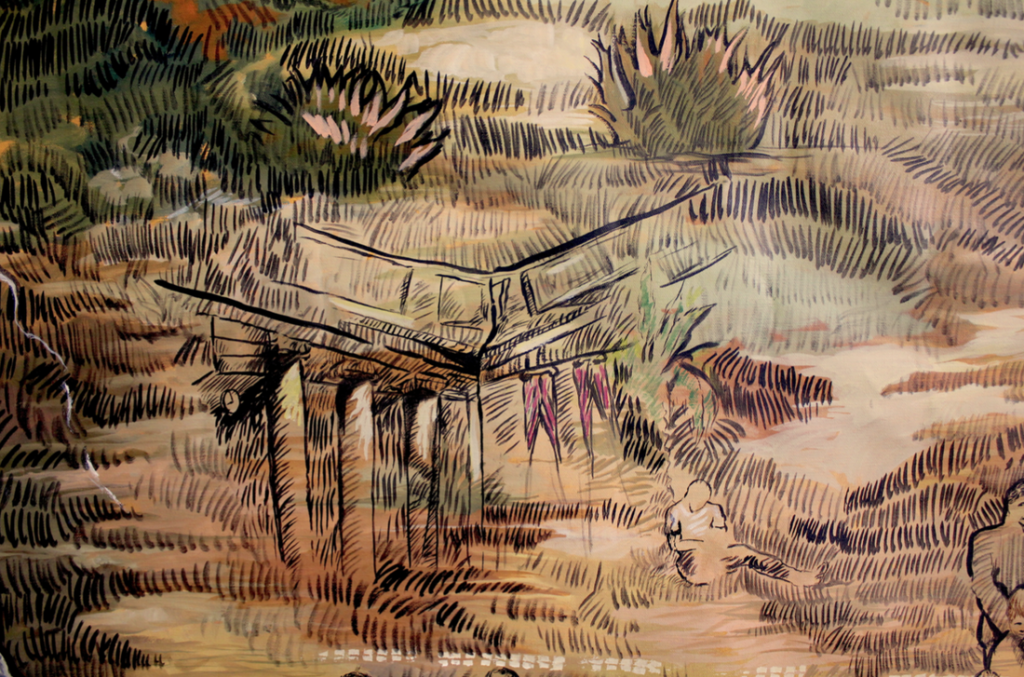
The paintings concealed my dark thoughts of revenge. A year later, tortured by my paintings, he lost his mind. He went on living his life in a haphazard way. And finally he burnt everything down: the paintings, his house and himself.
The fiction became reality during the MoMA exhibition, opened for Veteran’s Day and using Eyal’s work to advertise the exhibition on social media. Eyal writes:
They posted a picture of my artwork as an ad on their Instagram and Facebook pages without asking me, and the ad was an invitation to veteran soldiers [on Veterans Day]. For me it’s unacceptable that they should use my artwork to invite American military, so-called ‘Veterans.’ Maybe it’s a holiday for them, but for me it’s not a holiday. The veterans are the ones responsible for the destruction in my country.
In response, Eyal made one last work for his series Painting Size 80×60 cm; called My Nightmare at MoMA (for detail images and more context, go here).
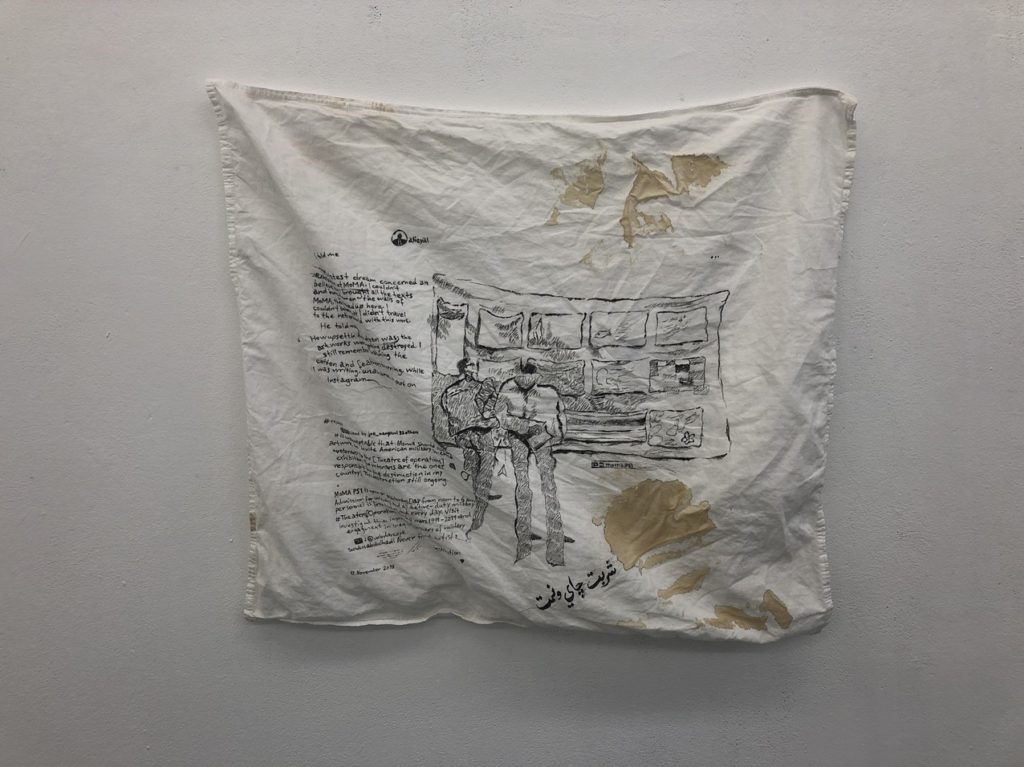
Eyal’s intervention turned Theater of Operations into an unfinished exhibition. But what do we do with the catalog? Is it obsolete because it fails to incorporate this moment during the run of the exhibition? Or can it still be used as a portal, an opening, a thread, leading us back there with a fuller picture of our own complicity within the House of No Name? Whisper it here: In US who hasn’t…Not yet, I cannot share my secret just yet. You’ll have to wait until after Nov. 3rd.
To be continued…
[‘Owned by No Name in Particular’ is an extract from Chapter 2: ECHOES of the ongoing online project Like Wind on Rushes which drafts a book to come called Whisper into a Hole.]